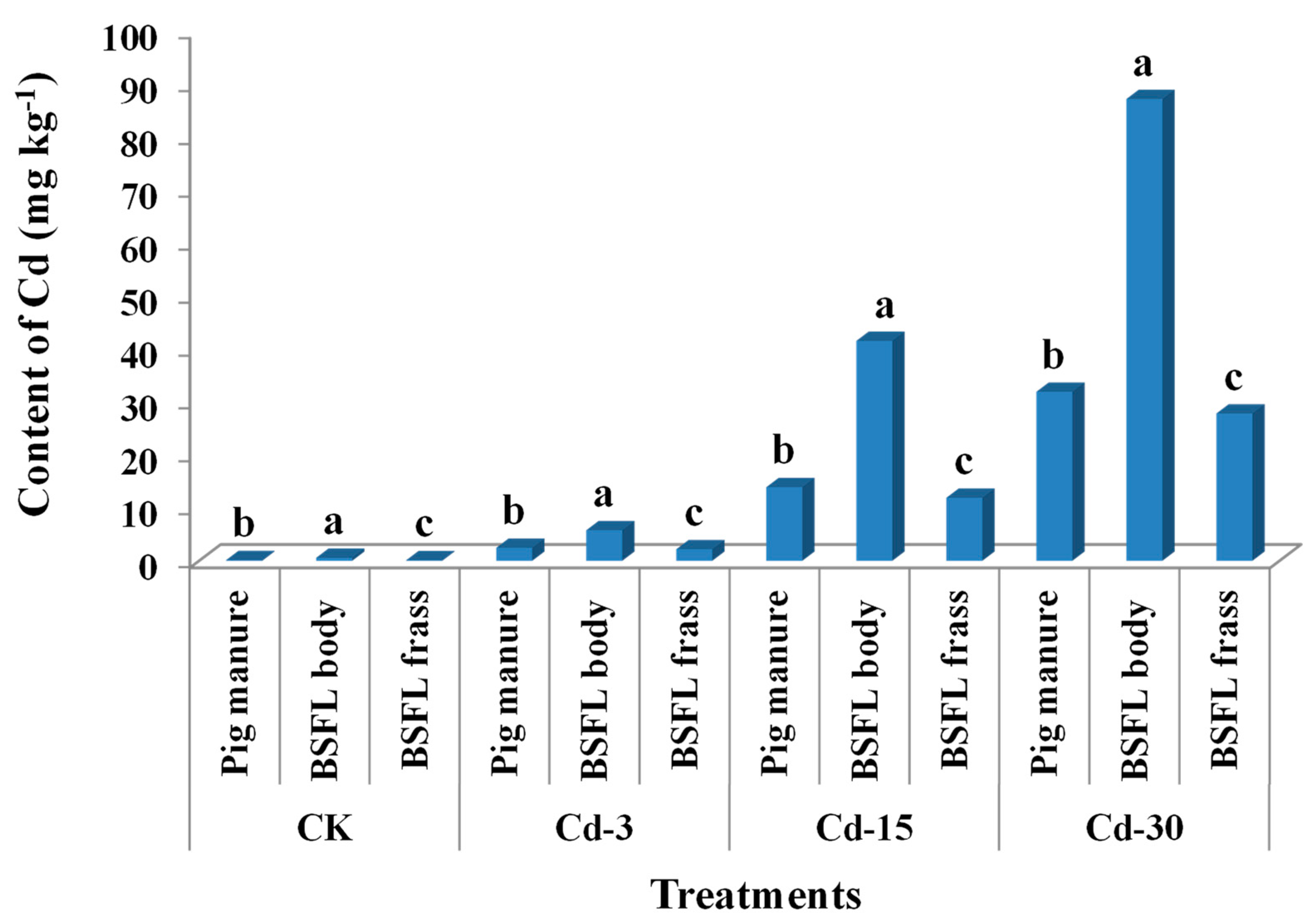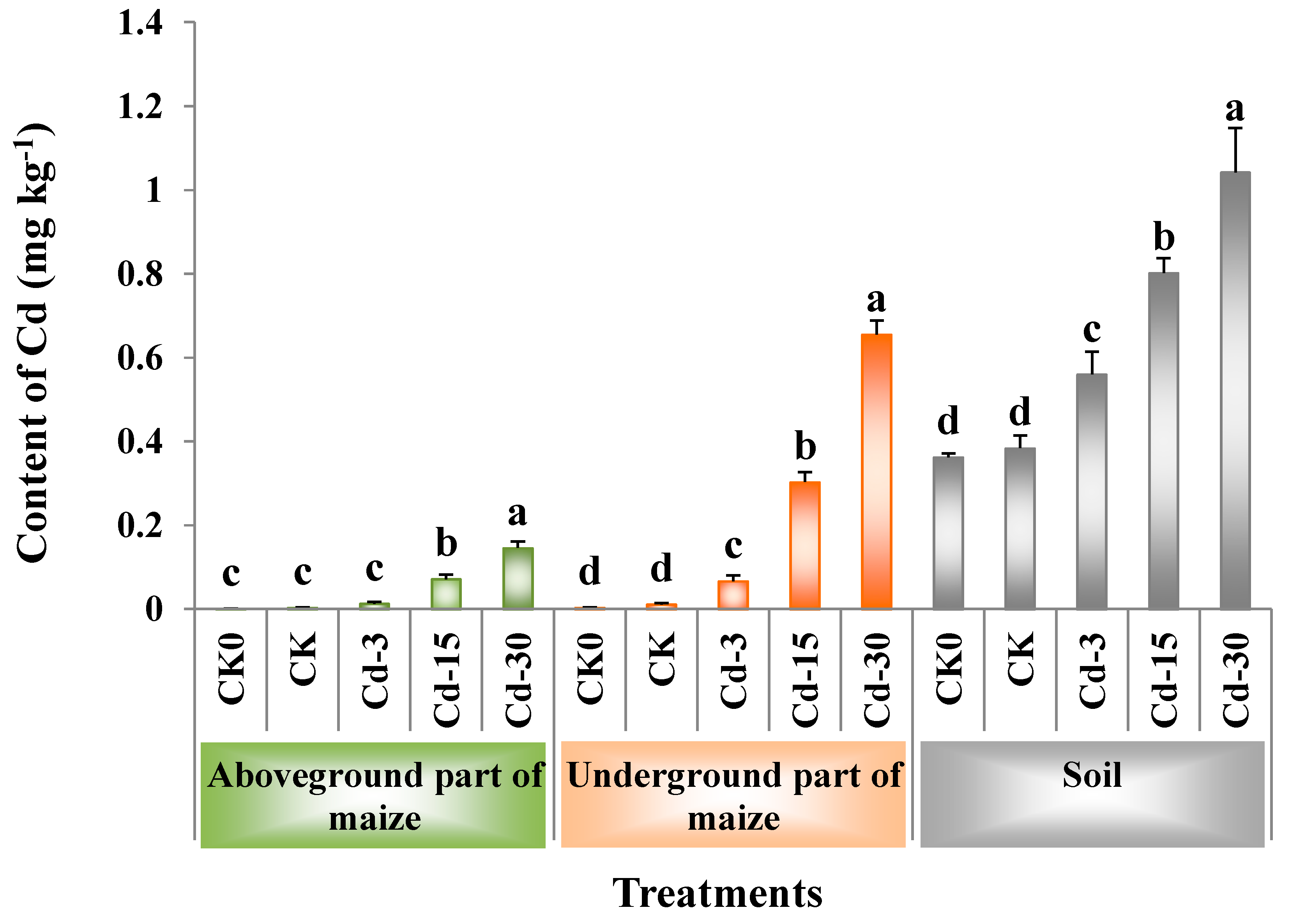Migration and Transformation of Cd in Pig Manure–Insect Frass (Hermetia illucens)–Soil–Maize System
Abstract
1. Introduction
2. Materials and Methods
2.1. Pig Manure Transformation by BSFL
2.2. Maize Growing Test
2.3. Determination Methods
2.4. Data Statistical Analysis
3. Result and Discussion
3.1. Effects of Cd on Production Performance of BSFL
3.2. Cd Contents in Pig Manure, BSFL Bodies, and BSFL Frass
3.3. Effects of BSFL Frass Application on Maize Growth Parameters
3.4. Cd Contents in Soil, and Aboveground and Underground Parts of Maize
3.5. Speciation of Cd in Pig Manure, BSFL Frass, and Soil
3.6. Migration of Cd in Pig Manure–BSFL Frass–Soil–Maize System
4. Conclusions
Author Contributions
Funding
Institutional Review Board Statement
Informed Consent Statement
Data Availability Statement
Conflicts of Interest
References
- Afazeli, H.; Jafari, A.; Rafiee, S.; Nosrati, M. An investigation of biogas production potential from livestock and slaughterhouse wastes. Renew. Sust. Energy Rev. 2014, 34, 380–386. [Google Scholar] [CrossRef]
- Hagemann, N.; Subdiaga, E.; Orsetti, S.; de la Rosa, J.M.; Knicker, H.; Schmidt, H.; Behrens, S. Effect of biochar amendment on compost organic matter composition following aerobic composting of manure. Sci. Total Environ. 2018, 613–614, 20–29. [Google Scholar] [CrossRef] [PubMed]
- Hashemi, M. Heavy metal concentrations in bovine tissues (muscle, liver and kidney) and their relationship with heavy metal contents in consumed feed. Ecotoxicol. Environ. Saf. 2018, 154, 263–267. [Google Scholar] [CrossRef] [PubMed]
- Pan, X.; Han, Z.; Pen, W. Heavy metal contents in pig manure and pig feeds from intensive pig farms in shandong province, China. J. Agro-Environ. Sci. 2013, 32, 160–165. (In Chinese) [Google Scholar] [CrossRef]
- Yang, X.; Li, Q.; Tang, Z.; Zhang, W.; Yu, G.; Shen, Q.; Zhao, F. Heavy metal concentrations and arsenic speciation in animal manure composts in China. Waste Manag. 2017, 64, 333–339. [Google Scholar] [CrossRef]
- Cai, M.; Ma, S.; Hu, R.; Tomberlin, J.; Thomashow, L.; Zheng, L.; Zhang, J. Rapidly mitigating antibiotic resistant risks in chicken manure by Hermetia illucens bioconversion with intestinal microflora. Environ. Microbiol. 2018, 20, 4051–4062. [Google Scholar] [CrossRef]
- Lalander, C.; Diener, S.; Magri, M.; Zurbrugg, C.; Lindstrom, A.; Vinneras, B. Faecal sludge management with the larvae of the black soldier fly (Hermetia illucens)—From a hygiene aspect. Sci. Total Environ. 2013, 458–460, 312–318. [Google Scholar] [CrossRef]
- Diener, S.; Zurbrugg, C.; Tockner, K. Conversion of organic material by black soldier fly larvae: Establishing optimal feeding rates. Waste Manag. Res. 2009, 27, 603–610. [Google Scholar] [CrossRef]
- Józefiak, D.; Józefiak, A.; Kierończyk, B.; Rawski, M.; Wi Tkiewicz, S.; Ugosz, J.; Engberg, R. Insects—A natural nutrient source for poultry—A review. Ann. Anim. Sci. 2016, 16, 297–313. [Google Scholar] [CrossRef]
- Newton, G.; Sheppard, D.; Watson, D.; Burtle, G.; Dove, C.; Tomberlin, J.; Thelen, E. The black soldier fly, Hermetia illucens, as a manure management/resource recovery tool. In Proceedings of the Symposium on the State of the Science of Animal Manure and Waste Management, San Antonio, TX, USA, 5–7 January 2005. [Google Scholar]
- Rehman, K.; Cai, M.M.; Xiao, X.P.; Zheng, L.Y.; Wang, H.; Abdul, A.S.; Zhou, Y.; Li, W.; Yu, Z.; Zhang, J. Cellulose decomposition and larval biomass production from the co-digestion of dairy manure and chicken manure by mini-livestock(Hermetia illucens L.). J. Environ. Manag. 2017, 196, 458–465. [Google Scholar] [CrossRef]
- Diener, S.; Nandayure, M.; Solano, S.; Gutiérrez, F.R.; Zurbrügg, C.; Tockner, K. Biological Treatment of Municipal Organic Waste using Black Soldier Fly Larvae. Waste Biomass Valor. 2011, 2, 357–363. [Google Scholar] [CrossRef]
- Biancarosa, I.; Liland, N.; Biemans, D.; Araujo, P.; Bruckner, C.; Waagbo, R.; Amlund, H. Uptake of heavy metals and arsenic in black soldier fly (Hermetia illucens) larvae grown on seaweed-enriched media. J. Sci. Food Agric. 2018, 98, 2176–2183. [Google Scholar] [CrossRef]
- Van der Fels-Klerx, H.; Camenzuli, L.; Van der Lee, M.; Oonincx, D.G.A.B. Uptake of cadmium, lead and arsenic by Tenebrio molitor and Hermetia illucens from contaminated substrates. PLoS ONE 2016, 11, e166186. [Google Scholar] [CrossRef]
- Wu, N.; Wang, X.; Yan, Z.; Xu, X.; Xie, S.; Liang, J. Transformation of pig manure by passage through the gut of black soldier fly larvae (Hermetia illucens): Metal speciation, potential pathogens and metal-related functional profiling. Ecotoxicol. Environ. Saf. 2021, 211, 111925. [Google Scholar] [CrossRef]
- Gao, Q.; Wang, X.; Wang, W.; Lei, C.; Zhu, F. Influences of chromium and cadmium on the development of black soldier fly larvae. Environ. Sci. Pollut. Res. 2017, 24, 8637–8644. [Google Scholar] [CrossRef]
- Wu, N.; Wang, X.; Xu, X.; Cai, R.; Xie, S. Effects of heavy metals on the bioaccumulation, excretion and gut microbiome of black soldier fly larvae (Hermetia illucens). Ecotoxicol. Environ. Saf. 2020, 192, 110323. [Google Scholar] [CrossRef]
- Sahuquillo, A.; Rauret, G.; Bianchi, M.; Rehnert, A.; Muntau, H. Mercury determination in solid phases from application of the modified BCR-sequential extraction procedure: A valuable tool for assessing its mobility in sediments. Anal. Bioanal. Chem. 2003, 4, 578–583. [Google Scholar] [CrossRef]
- Wang, X.B.; Wu, N.; Cai, R.J.; Geng, W.N.; Xu, X.Y. Changes in speciation, mobility and bioavailability of Cd, Cr and As during the transformation process of pig manure by black soldier fly larvae (Hermetia illucens). J. Integr. Agr. 2021, 20, 1157–1166. [Google Scholar] [CrossRef]
- Mireji, P.; Joseph, K.; Ahmed, H.; Impoinvil, D.; Mbogo, C.; Muturi, M.; Hudson, N.; Kenya, E.; Githure, J.; Beier, J. Expression of metallothionein and α-tubulin in heavy metal-tolerant Anopheles gambiae sensu stricto (Diptera: Culicidae). Ecotox. Environ. Saf. 2010, 73, 46–50. [Google Scholar] [CrossRef]
- Braeckman, B.; Smagghe, G.; Brutsaert, N.; Cornelis, R.; Raes, H. Cadmium uptake and defense mechanism in insect cells. Environ. Res. 1999, 80, 231–243. [Google Scholar] [CrossRef]
- Cai, W.Z. General Entomology; China Agriculture Press: Beijing, China, 2001. (In Chinese) [Google Scholar]
- Wu, G.; Zhu, J.; Gao, X. Study on accumulation and excretion of dietary cadmium and copper by Boettcherisca peregrine (Dilotera Sarcophagidae). J. Environ. Entomol. 2010, 3, 347–352. (In Chinese) [Google Scholar] [CrossRef]
- Ballan-Dufrancais, C. Localization of metals in cells of pterygote insects. Microsc. Res. Tech. 2002, 56, 403–420. [Google Scholar] [CrossRef] [PubMed]
- Proc, K.; Bulak, P.; Wiacek, D.; Bieganowski, A. Hermetia illucens exhibits bioaccumulative potential for 15 different elements—Implications for feed and food production. Sci. Total Environ. 2020, 723, 138125. [Google Scholar] [CrossRef] [PubMed]
- Beesigamukama, D.; Mochoge, B.; Korir, N.; Musyoka, M.; Fiaboe, K.; Nakimbugwe, D.; Khamis, F.; Subramanian, S.; Dubois, T.; Ekesi, S.; et al. Nitrogen fertilizer equivalence of black soldier fly frass fertilizer and synchrony of nitrogen mineralization for maize production. Agronomy 2020, 10, 1395. [Google Scholar] [CrossRef]
- Wang, X.; Wu, N.; Wu, X.; Geng, W.; Xu, X. Effect of insect feces (Hermetia illucens) on rice growth and heavy metal migration from polluted soil to rice plant. Environ. Sci. Pollut. Res. 2022, 29, 14695–14704. [Google Scholar] [CrossRef]
- Menino, R.; Felizes, F.; Castelo-Branco, M.A.; Fareleira, P.; Moreira, O.; Nunes, R.; Murta, D. Agricultural value of black soldier fly larvae frass as organic fertilizer on ryegrass. Heliyon 2021, 7, e05855. [Google Scholar] [CrossRef]
- Zhao, X.; Cao, Y.; Li, Y.; Pan, G.; Lin, H. The variational study of physiological characteristics and translocation ability of maize seeding with Cd Stress. Acta Agri. Boreali-sinica . 2015, 30, 119–127. (In Chinese) [Google Scholar] [CrossRef]
- Patra, J.; Lenka, M.; Panda, B. Tolerance and co-tolerance of the grass Chloris barbata Sw. to mercury, cadmium and zinc. New Phytol. 1994, 128, 165–171. [Google Scholar] [CrossRef]
- Bavi, K.; Kholdebarin, B.; Moradshahi, A. Effect of cadmium on growth, protein content and peroxidase activity in pea plants. Pakistan J. Botany. 2011, 43, 1467–1470. [Google Scholar] [CrossRef][Green Version]
- Wu, R.; Liu, S.; Sun, H.; Du, Y.; Ma, L. Effects of long-term chemical fertilizer combined with different organic fertilizers on heavy metal accumulation in soil and maize. J. Plant Nutr. Fert. 2020, 11, 2010–2019. (In Chinese) [Google Scholar] [CrossRef]
- Wang, A.; Wang, M.; Liao, Q.; He, X. Characterization of Cd translocation and accumulation in 19 maize cultivars grown on Cd-contaminated soil: Implication of maize cultivar selection for minimal risk to human health and for phytoremediation. Environ. Sci. Pollut. Res. 2016, 23, 5410–5419. [Google Scholar] [CrossRef]
- Lin, J.; Cheng, C.; Han, M. Effects of diatomite organic fertilizer on Cd and Zn forms and availability of Cd-Zn polluted soil. J Agri. Resour. Environ. 2014, 8, 366–371. [Google Scholar] [CrossRef]
- Tian, Y.; Wang, X.; Lin, R.; Yu, H. Single and combined aging of cadmium, lead and zinc in soil. J. Agro-Environ. Sci. 2008, 1, 156–159. (In Chinese) [Google Scholar] [CrossRef]
- Pardo, M. Sorption of lead, copper, zinc, and cadmium by soils: Effect of nitriloacetic acid on metal retention. Commun. Soil Sci. Plant Anal. 2000, 31, 31–40. [Google Scholar] [CrossRef]
- Phillips, I.R. Copper, lead, cadmium, and zinc sorption by waterlogged and air-dry soil. J. Soil Contam. 1999, 3, 343–364. [Google Scholar] [CrossRef]
- Tahir, N.; Danish, S.; Aka, H.; Ullah, A.; Hussain, B. Strategies for reducing cd concentration in paddy soil for rice safety. J. Clean. Prod. 2021, 316, 128116. [Google Scholar] [CrossRef]




| Treatment | Fresh Weight of Obtained BSFL (kg) | Dry Weight of Obtained BSFL (kg) | Dry Weight of BSFL Frass (kg) |
|---|---|---|---|
| CK | 2.59 ± 0.08a | 0.70 ± 0.016a | 5.47 ± 0.26a |
| Cd-3 | 2.71 ± 0.06a | 0.73 ± 0.022a | 5.34 ± 0.13a |
| Cd-15 | 2.73 ± 0.08a | 0.74 ± 0.022a | 5.35 ± 0.12a |
| Cd-30 | 2.69 ± 0.06a | 0.73 ± 0.034a | 5.37 ± 0.13a |
| Treatment | Plant Height (cm) | Chlorophyll (SPAD) | Photosynthetic Rate (μmol/(m2·s)) | Dry Weight of Aboveground Parts (g) | Dry Weight of Aboveground Parts (g) |
|---|---|---|---|---|---|
| CK0 | 103.6 ± 3.4b | 15.6 ± 0.5c | 17.5 ± 2.1c | 34.8 ± 2.2c | 6.5 ± 0.9c |
| CK | 148.8 ± 5.3a | 25.7 ± 1.6a | 30.5 ± 3.8a | 94.3 ± 7.5a | 19.3 ± 1.5a |
| Cd-3 | 146.6 ± 5.8a | 25.3 ± 1.6a | 30.8 ± 2.4a | 93.6 ± 8.9a | 19.0 ± 1.0a |
| Cd-15 | 150.5 ± 2.0a | 25.4 ± 1.3a | 30.7 ± 2.1a | 93.9 ± 5.0a | 18.9 ± 1.4a |
| Cd-30 | 143.3 ± 5.2a | 22.4 ± 0.7b | 24.2 ± 3.0b | 76.7 ± 8.6b | 16.2 ± 1.3b |
Disclaimer/Publisher’s Note: The statements, opinions and data contained in all publications are solely those of the individual author(s) and contributor(s) and not of MDPI and/or the editor(s). MDPI and/or the editor(s) disclaim responsibility for any injury to people or property resulting from any ideas, methods, instructions or products referred to in the content. |
© 2022 by the authors. Licensee MDPI, Basel, Switzerland. This article is an open access article distributed under the terms and conditions of the Creative Commons Attribution (CC BY) license (https://creativecommons.org/licenses/by/4.0/).
Share and Cite
Wang, X.; Wu, N.; Ma, Y.; Wang, Z.; Cai, R.; Xu, X. Migration and Transformation of Cd in Pig Manure–Insect Frass (Hermetia illucens)–Soil–Maize System. Int. J. Environ. Res. Public Health 2023, 20, 60. https://doi.org/10.3390/ijerph20010060
Wang X, Wu N, Ma Y, Wang Z, Cai R, Xu X. Migration and Transformation of Cd in Pig Manure–Insect Frass (Hermetia illucens)–Soil–Maize System. International Journal of Environmental Research and Public Health. 2023; 20(1):60. https://doi.org/10.3390/ijerph20010060
Chicago/Turabian StyleWang, Xiaobo, Nan Wu, Ye Ma, Zhiqiang Wang, Ruijie Cai, and Xiaoyan Xu. 2023. "Migration and Transformation of Cd in Pig Manure–Insect Frass (Hermetia illucens)–Soil–Maize System" International Journal of Environmental Research and Public Health 20, no. 1: 60. https://doi.org/10.3390/ijerph20010060
APA StyleWang, X., Wu, N., Ma, Y., Wang, Z., Cai, R., & Xu, X. (2023). Migration and Transformation of Cd in Pig Manure–Insect Frass (Hermetia illucens)–Soil–Maize System. International Journal of Environmental Research and Public Health, 20(1), 60. https://doi.org/10.3390/ijerph20010060






